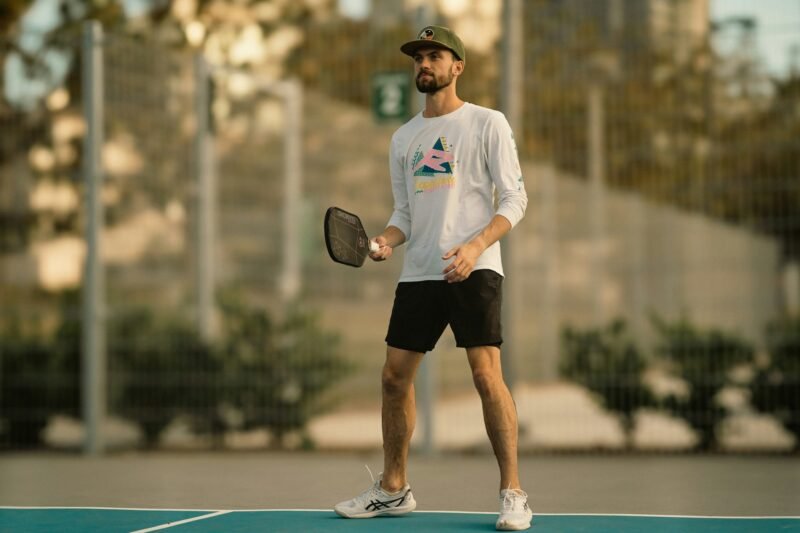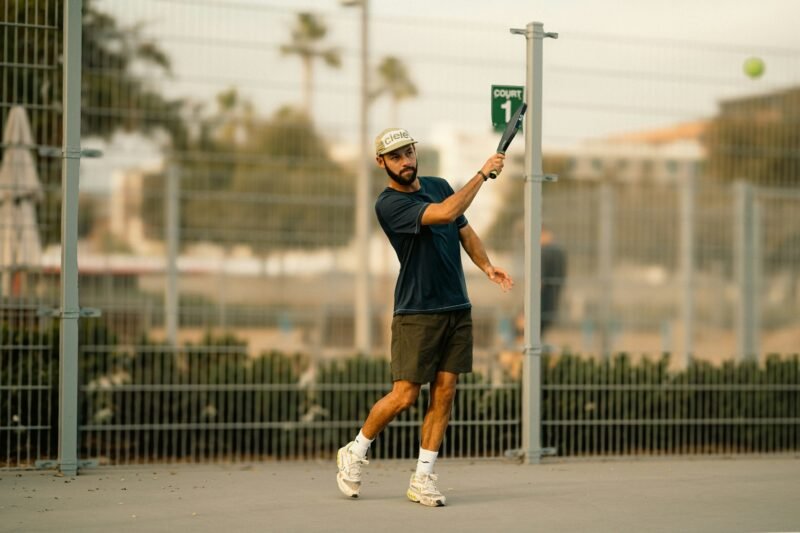How to Play Pickleball: A Beginner’s Guide to Rules, Equipment, and Strategy
Prefer to listen? Tap play below!
Pickleball: a sport that’s been taking the U.S. and the world by storm. The wonderful thing about pickleball is that anyone can play it, from children to seniors. It’s a sport created from parts of tennis, badminton, and table tennis. And it’s a sport that lets family and friends have matches together, that’s enjoyable and doesn’t involve much physical activity.
Here’s the lowdown on what you need to know about the sport of pickleball including how to play, the dimensions of a pickleball court, and strategies to enhance your enjoyment and performance.
- Dimensions of a Standard Pickleball Court (20 feet wide x 44 feet long for both singles and doubles play)
- Pickleball Net Height (36 inches at the ends / 34 inches at the middle)
Similar to badminton, a game of pickleball is played in either singles format (1 vs. 1) or doubles format (2 vs. 2).
In pickleball, there is a rule called the two-bounce rule (also known as the double-bounce rule) where the serve and return of serve must bounce before either side can volley (hitting the ball out of the air without letting it bounce) the ball.
The lone server will be positioned on the right/even side of the court when his/her team has scored an even number of points. The server will be positioned on the left/odd side when the team has scored an uneven number of points.

Group of four young adults chatting and smiling after the match on the court stadium. Holding pickleball paddles
Matches are exciting. And yes, you can bet I love to play a game or two during my free time. But when you are just introducing yourself to the game, it’s best not to restrict yourself to exclusive matches and let yourself have fun.
A player is allowed to let the ball bounce once before hitting it back over the net.
The first player (or team) to get to 11 points, with a difference of 2 points, wins the game. For those who like the competitive side of things, matches in pickleball are usually won over the best of three games.
Pickleball Court Dimensions
A standard pickleball court is 20′ x 44′ for both singles and doubles play. It’s laid out like a badminton court, with its badminton-esque net pulled tight to a height of 36” at the sidelines and 34” at the center. The court is divided in half by this net. The service area, otherwise known as ‘where you’re supposed to serve from,’ is located along the baseline, like golfers teeing off into the fairway. Its 20’ of width (16.5’ for singles play) is split into two equal sections of 10’ each, along an imaginary center line that extends from the net to the baseline. This is the position players take to prepare to launch a serve into their opponent’s service box.
Think of it as the perfect place to attempt to set the table for an ‘easy win’ or force your opponent to defend. Located between the baseline and the kitchen line, the serving area is the section of the court you must serve in to. In other words, drop that serve into your opponent’s 10’ deep service area (a.k.a. service box) that extends from the imaginary centerline to the outside boundary (sideline). You’ll note that serves along the centerline are often a bit more difficult to predict. The section of the court directly adjacent to the non-volley line is officially known as the non-volley area, or as you can imagine, the name has been shortened to the ‘kitchen’ by some. The kitchen in pickleball is somewhat unique compared to other sports because you’re not allowed to volley a ball from this area.
Sidelines and Baselines: On all pickleball courts, you’ll also most likely find sidelines and baselines, as these simple markers are used in a similar sense that other sports also use lines to determine the ‘in-and-out of play’. If the ball lands outside the lines, it’s considered ‘out’ and the point is awarded to the team that didn’t hit it out. If the ball lands on the line, it is considered ‘in’. The one exception to this rule is when the serve lands on the kitchen line. In this case, it is considered landing in the kitchen and is ‘out’.
You’d better come prepared! Each of the areas of a pickleball court is designed for a purpose, with strategies sure to follow. What we’ve learned is that the overall ‘court layout’ contains a list of rules that you should become familiar with.
Understanding the Basics of Pickleball
Pickleball was invented in 1965 on Bainbridge Island, Washington, by three dads: Joel Pritchard, Bill Bell, and Barney McCallum. They were looking to entertain their bored kids. With improvised gear and a badminton court, they created a sport that combined tennis, badminton, and ping-pong.
Originally a backyard pastime, pickleball slowly grew across the U.S. through local clubs and rec centers. Its easy entry and minimal equipment helped it spread globally. Canada, Asia, and Europe have now embraced the game, with official tournaments and governing bodies elevating its status.
- Games are played in singles (1v1) or doubles (2v2) format
- The double bounce rule means the ball must bounce once on each side before players can volley
- Serves are underhand and must land diagonally in the service box
- Only the serving team scores points
- First to 11 points wins (must win by 2)
Though simple at first glance, pickleball rewards smart positioning, tactical shot selection, and controlled pace. Players use dinks, lobs, and drives to outmaneuver opponents, making it a dynamic, cerebral sport; not just about speed or power.

Pickleball is low-impact and easy to learn, making it ideal for kids, seniors, and everyone in between. Whether you’re chasing medals or enjoying a casual game with friends, its inclusive nature brings people together on and off the court.
From school gyms to senior communities, pickleball thrives in spaces where connection and movement are valued. The rules are simple enough for beginners, yet nuanced enough to challenge seasoned athletes making it truly timeless and welcoming.
Essential Pickleball Equipment
Pickleball is seeing a surge of interest due to its unique combination of tennis, badminton, and table tennis. Pickleball is quite easy to get into because players only need a few key pieces of equipment: the paddle, the ball, and the right shoes.
Be sure to get a feel for all possible paddles before settling on one. It’s one of the key pieces of equipment of pickleball, so understanding its specifics will be the deciding factor on how players begin. The paddle will vary in weight, grip size, and the actual material of its construction. Lighter paddles are easier to maneuver, but heavier paddles can put more power behind the ball. The grip size is pretty important because you don’t want the grip that is too small or too large, which could lead to play issues. Beginner players might benefit from heading to a physical store to get a feel for some models.
The pickleball ball comes in two variations: indoor and outdoor. Indoor balls are a little bit bigger in size and lighter; they tend to do well in the safe confines of a gymnasium or anything like that. Outdoor balls are heavier and a bit smaller as you do not want wind to affect the match, so just keep these facts in mind. Beginning players would typically choose a ball that corresponds well to the environment where they play the most.
However, safety gear should always be involved if you are always trying to improve. Make sure that your shoes have at least a little bit of cushioning. A court shoe will be fine but a tennis shoe will have enough grip to be perfect as well. Since we constantly try to position ourselves in a more effective position against the opponent team, we only want to play at our fullest.
Pickleball Rules for Beginners
Pickleball, a mash-up of tennis, badminton, and table tennis that’s the fastest-growing sport in America, has an entirely unique set of rules and strategies that are foreign to even the most seasoned athletes. Changing these mental paradigms can be the most challenging part of learning the sport for many people. Mounting research has shown huge cognitive benefits of learning a new sport as an adult, so don’t shy away from the sport’s complexities. But, before you try out for a local tournament, consider brushing up on a few rules of the road so you don’t lose yourself out of a match for an unnecessary fault.
Scoring
Pickleball games are played to 11 points and must be won by two. Only the serving team can score points. That means when the receiving team wins the rally, they simply gain the serve without scoring any points. This quirk leads to extended games where strategy can really come into the fold: Because the only team that gets a point after every rally is on the serving side, pickleballers must pick their moments wisely, and that typically means avoiding reckless play whenever possible.
Serving
For someone with a monstrous forehand, serving underhand in pickleball can be somewhat vexing, but those are the rules. In fact, you’ll gain a fault for aggressive service. Every serve in pickleball must be served underhand, with the server’s palm facing upward and the paddle making contact with the ball below the waist. To serve, stand behind the baseline and hit the ball into the service box, diagonally opposite from where you’re positioned.
Faults
You commit a fault when you violate one of the rules of the game; the other side gets a point. Here are a few simple faults to avoid:
- You hit the ball out of bounds: Can happen to anyone.
- You hit it in the kitchen.
- You served when you were not the server: Happens to anyone who isn’t paying attention.
- You hit the ball before it bounces on your side of the court after it was served: It seems simple, but it does happen, so let that serve bounce before returning your volley.
Basic Pickleball Strategy
Pickleball, you will find, is not only fun but is easy to learn and easy to play. Plus, it’s so addictive you’ll feel like you can chase that colorful little ball around for hours on end. But it’s not all fun and games; being ready to compete is about sticking to a game plan and being ready for the upcoming shot. That’s why we’re going to look at pickleball from a different perspective, one of the top areas where many beginners could use just a little nudge in the right direction.
Position yourself for advantage: Many beginners make the mistake of playing too close to the baseline. If you can get to the net, by all means, do it! Trust me, it doesn’t take more than a couple of games to stop being an easy target for your opponents.
Get into a flow: When you hit a returnable serve, get in the habit of coming up to the net. Do everything you can to keep your opponent(s) on the run: execute deep crosscourt returns, drop your shots short and lob shots over the top.
Prepare for the shot: Get your paddle back and move sideways in order to be in position for the volley. Why give away free points when you can get in the ready position and stay in the game.

As busy as work and family life can get, let the temptation persist. As demanding as it is, it will push you to put your body through the motions. Pickleball can be quite a strategic game; if you’re not good, maybe your partner is! You’ll be hooked, I promise. Challenge your friends and get your own pickleball set. You won’t regret it.
Final Thoughts for New Players
The article covers what the court looks like, what types of equipment you’ll need, some of the basic rules that govern game play, and some of the strategies you’ll want to employ to win.
There are lines on the court that designate the dimensions where you can serve the ball, where the ball might land, where you can stand, and where you might want to avoid entirely.
You’ll need both a paddle and a pair of shoes. Not all paddles are created equal. Some are lighter and weigh less than 7.0 ounces, whereas others push the upper end of the spectrum and weigh over 8.5 ounces. Shoes made for tennis will give you enough support and traction to prevent injury, regardless of the court surface type.
There are many rules in pickleball and you have to follow all of them if you want to play the “right” way. You’ll need to know these rules to play the game. You’ll also need to understand these rules to communicate with your partner and with your opponents.
There are also several other “tactics” you can employ to score more points against your opponents. Experiment with different service types: try serving with a lot of power to back your opponents off of the kitchen line, or serve as short as you can make the ball go to draw them closer to the net. Do whatever you need to do to break up their rhythm and prevent them from executing their game plan.
Now get out there and start playing some games of pickleball! You’ve got the basics, now is a perfect time to apply them for real with some live game situations.
We cover different pickleball techniques in other articles on our site. Never miss a beat with the latest tips and research. Click through to level up your game, and we’ll see you on the other side.
Other Articles
Pickleball Tips for Playing with Hearing Loss
Pickleball Tips for Playing During Pregnancy
Pickleball Tips for Playing with Disabilities
Pickleball Tips for Playing with Injuries
Pickleball Tips for Playing in Humid Conditions
Pickleball Tips for Playing in High Altitude
Pickleball Tips for Playing on Wet Courts
Pickleball Tips for Playing at Night
Pickleball Tips for Playing in Cold Weather

